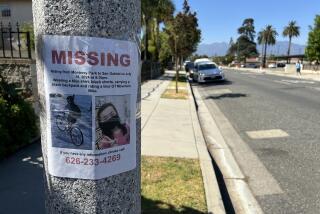Torrance Runaway Comes Home : Milk Carton Photo Pays Off
- Share via
Fifteen-year-old Denise Lucille Cramer had been missing from her Torrance home since Thanksgiving weekend, when a family fight prompted the teen-ager to run away.
After searching for nearly five months, Denise’s mother and stepfather still had no idea where she was.
Then the high school freshman’s photograph was placed on milk cartons, shopping bags, corporate newsletters and an estimated 5 million posters nationwide as part of a Los Angeles County Sheriff’s Department missing-children program.
Leads started trickling in.
“I had one child who came up to me and said she had seen Denise’s picture on a milk carton and it got her to thinking, and she thought she ought to offer what she could,” said Bruce Wilkerson, Denise’s stepfather. The girl, an acquaintance of Denise, knew she was somewhere in Wyoming.
Then a boy who knew Denise saw her picture on a milk carton and had his father call to see if there was a reward, Wilkerson said. The youth was eventually persuaded to reveal that Denise was in Casper, Wyo., where her parents picked her up last week.
“We’re very happy,” Wilkerson said. “There’s no question that the program was instrumental in finding her. We weren’t getting anywhere until her picture appeared on the milk cartons and shopping bags.”
Denise is one of 14 children who have been pictured in the sheriff’s program since it started in January, under the corporate sponsorship of Potlatch Corp. of Pomona and Alta-Dena Dairy in Industry. The program not only features the missing children’s pictures on milk cartons made by Potlatch and distributed through Alta-Dena and Ralph’s Supermarkets, but also sends the photographs to about 60 corporations that reprint them on everything from shopping bags to company mailings.
Of the 14 children who have been pictured, Denise is one of five found.
“When people see the missing children’s faces on those milk cartons, it can’t do anything but good,” said Sheriff’s Detective Galen O. Sabean, who runs the program. “We get a lot of calls from having the pictures publicized, and it has helped to make the program a success.”
Dona Wilkerson, Denise’s mother, credits the program and Sabean for helping her family. “The program is excellent,” she said. “It would have been difficult to find Denise without the program. . . . People saw her picture on the milk carton and the shopping bags, and that helped, but so did the efforts of Lt. Galen Sabean. He never stopped being concerned.”
Dona Wilkerson said Sabean called her at least once a week to check for any tips on Denise and she credited his persistence for the couple’s success in finding their daughter.
But Sabean countered, “I don’t think I can take the credit for this. The public who responded to the photograph deserves the credit. When the public takes the time to look at the milk cartons and call me, I just follow up . . . I keep in contact with the families because it builds their spirits a bit.”
“His concern helped keep my wife’s sanity,” Wilkerson said. “For most of the first five months, my wife was so worried about our child that she didn’t leave the house. She just stayed by the phone--she was a recluse.”
At one time, Wilkerson said, the worried couple heard a tip--which turned out to be true but several weeks old--that their daughter was living in Manhattan Beach.
“We combed the streets,” he said. “We stopped in restaurants where we thought she might be working and we stopped people on the street and showed them her picture. Like any parents, we just couldn’t stop trying.”
Most frustrating, the Torrance parents say, were their suspicions that some of their neighbors’ children knew where Denise was but did not volunteer information until the publicity began.
“There were people in this community who had knowledge of where Denise was and were not coming forward,” Wilkerson said. “I think that’s a crime.”
The Wilkersons said they were especially worried because they thought their daughter--a former student at South High School in Torrance, now enrolled in a private high school--was not the kind of teen-ager who would run away.
“She was on the cross-country track team and she had just gotten the best report card ever,” said Wilkerson. “She had been accepted into Job’s Daughters (an organization for young women) and she was on the Civil Air Patrol. . . . She was very popular with the other students. The people who knew her best, including her family, couldn’t believe it. . . . I think this is a symptom of our times.”
Denise, her parents say, is glad to be home but they didn’t want her to be interviewed because the family is still recovering from the ordeal. She had been living with a Christian family and working at a restaurant while in Wyoming, her parents said. Apparently, she had told the family and her boss that she was 19 years old.
“She said that she’s glad it’s all over now,” Wilkerson said. “She was ready and willing to come home. She said she realized that she was too young to be out there and she was ready to come home. . . . She had been afraid to call us.”
The Wilkersons, who said that they told their story to The Times so it might help other parents, said they would advise parents to keep in closer touch with their children.
“I guess we’d tell other parents to talk more to their kids and listen to them,” Wilkerson said.
Sabean said that most missing children are runaways, like Denise, or have been abducted by family members, usually in a custody battle. Very few, he said, are abducted by strangers.
Sabean also added that very few missing children in Los Angeles County are gone as long was Denise. About 97%, he said, are home within 30 days.
“When they’re gone more than 30 days and no one’s heard from them, like with Denise, there’s food for thought and reason for concern,” Sabean said. “Then we look at their track record--whether they run away two or three times a year or what the pattern is--and we look at their age.”
If a child is younger than 16, does not usually run away and has not been in contact with parents for more than 30 days, he or she is a likely candidate for a future milk carton photo, Sabean said.
“We think it can really help in these cases.”
More to Read
Sign up for Essential California
The most important California stories and recommendations in your inbox every morning.
You may occasionally receive promotional content from the Los Angeles Times.












